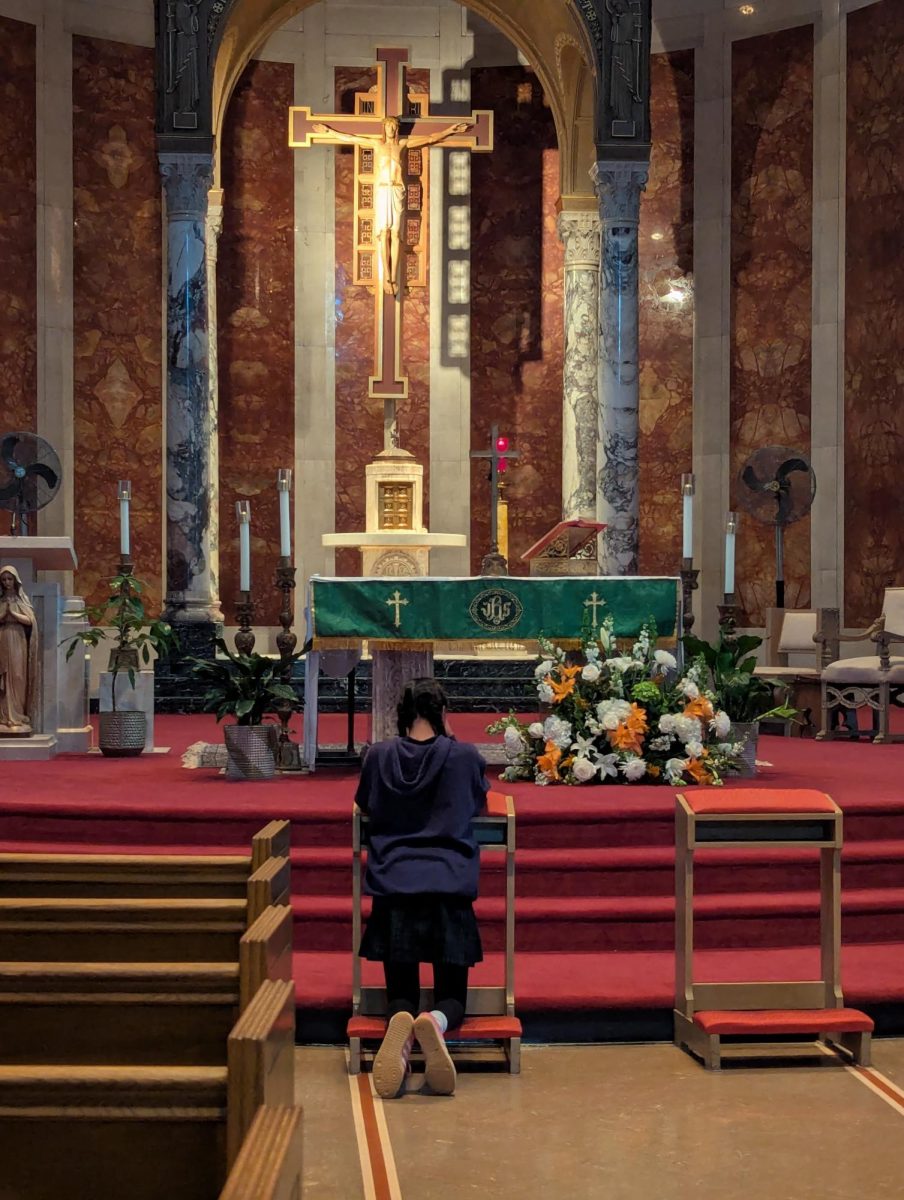The Rosary is one of the many wonderful ways a person can choose to pray; it is a meditative prayer especially dedicated to praying for the intercession of Mary. The rosary includes many different prayers including the Hail Mary (the one that is said most), the Our Father, the Apostles’ Creed, the Glory Be, Fatima Prayers, and the Hail Holy Queen. The rosary starts with doing the Apostles’ Creed, then moves into doing an Our Father. After that, it transitions into three Hail Mary’s offered for an increase in faith, hope, and charity. Then, the Glory Be is said with five decades, each consisting of one Our Father, ten Hail Marys, a Glory Be, and a brief Fatima Prayer. The rosary is then concluded with the Hail Holy Queen and sometimes with a prayer for the pope. Most people don’t pray the rosary in their free time, but Ms. Adamiec, a 5th grade teacher at St. Robert, says that she prays the rosary every day and enjoys it though the rosary is repetitive.
St. Robert prays a living rosary once a year during October. The school gets together in the church with a selection of students from each grade/class to lead; these individuals pray one prayer from the Rosary out loud. All the other students listen and pray along with their rosaries. The students who lead start by reciting the first half of the prayer before the other students join in at the second half. Netta, a 7th grader at St. Robert says, “[the living rosary] is very inspiring and it helps me grow closer to God”.
The mysteries of the rosaries are an important aspect of this prayer. The rosary has a collection of four groups of mysteries: Joyful, Luminous, Sorrowful, and Glorious. The mysteries all inform people about what Mary went through as the mother of Jesus. Evelyn, a 7th grade student at St. Robert states that she thinks nativity is the most important mystery. The Joyful mysteries talk about Gabriel announcing Jesus’ birth (the annunciation), Mary visiting Elizabeth (the visitation), Jesus being born (the nativity), Jesus being presented in the temple (the presentation), and Mary finding Jesus in the temple (the finding of jesus in the temple).
The Luminous mysteries explain the baptism of Jesus (the baptism of our Lord), the wedding when Jesus turned water to wine (the wedding at Cana), when Jesus proclaimed the Gospel (the proclamation of the kingdom), Jesus told the disciples to not be afraid (the transfiguration of the lord), and when Jesus instituted the eucharist (the institution of the eucharist).
The sorrowful mysteries are Jesus praying to God (the agony in the garden of gethsemane), when Jesus was tortured (the scourging at the pillar), Jesus was crowned with thorns (the crowning of thorns), Jesus carried the cross (the carrying of the cross), and when Jesus was crucified and died (the crucifixion and death).
Last, the glorious mysteries are Jesus getting resurrected (the resurrection), Jesus rises into heaven (the ascension), the holy spirit went across the disciples (the holy pentecost), Mary was taken into heaven-body and soul (the assumption), and the coronation of Mary (the coronation of our lady in heaven).
People all over the world pray the rosary. 6th grader Aylani from St. Josaphat mentions: “I pray the rosary after school with the entire school.” Aylani prays the rosary with her entire school, but people don’t have to do that. Anyone can pray the rosary at any time. In quiet places, or even with friends, people can pray the rosary. People show their love for Mary when praying the rosary, and that is important. Every prayer of the rosary gives Mary the love she needs.






Molly Mathews • Jan 15, 2025 at 1:27 pm
Sadie – I love all of your articles; you are doing a great job!! Thank you for concentrating on our Catholic Faith!
Loghan O • Jan 15, 2025 at 1:26 pm
Good job Sadie E making the religion documents